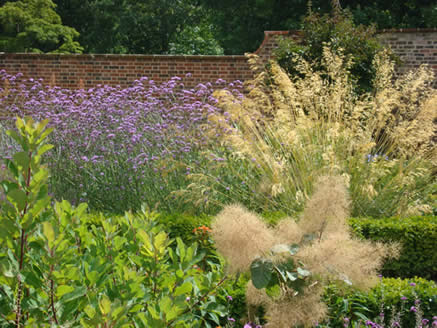Stirrings at the deep end
21 August 2009
Fish (fly-replete, in depth of June.
Dawdling away their wat’ry noon)
occupy hours of my garden time. Rupert Brooke was good on fish. He must have spent his Grantchester days day-dreaming by the river.
‘In a cool curving world he lies
And ripples with dark ecstacies …..’
We moved two well-grown mirror carp from the duckpond to the much smaller and shallower Red Sea a couple of years ago, hoping that they might be of complementary genders. One hot day last week I was reading in the hammock strung between two birches by the water when I heard a different kind of splash and turned to see what looked like a whirlpool, made up of a hundred tiny carp chasing each other’s tails. I imagine they must just have hatched and were learning to swim in tight formation. No fussing from mama, though – and which of the two sleek fish calmly cruising at the far end of the pool is mama, anyway?
What happens next will be attrition, I fear. Will it be death from the skies when the heron spots them? The Red Sea would be crowded with as many as half a dozen full-grown carp. And will the resident rudd have their fins put out of joint?
A new leaf
18 August 2009
Regular readers will have seen my rather shell-shocked reports of two burglaries that have left the garden bereft of some of its principal non-plant ornaments. The second and more serious raid was three weeks ago now, on the very night I went down with flu, but I’m still obsessing, above all about my folly in leaving an ideal barrow where thieves could use it. (They stole it too). Take my advice: lock up your barrows. Everything has a bright side, though, and the absence of long-familiar objects frees up some fossilized notions. I loved the armillary sphere on the front lawn of the house because it was as transparent as it was emphatic. It didn’t block the view; it seemed to focus it. Certainly without it the prospect looks rather inspid. So what shall we put in its place?
I have always loved Pope’s urn, the design done by William Kent for the
Identity Parade
17 August 2009
To Wisley for a day’s immersion in limes, trees as easy to spot as they are hard to tell apart. I don’t usually delve this deep in botany, but when the R.H.S. Woody Plant Committee convenes a Study Day you are guaranteed the best and most experienced minds in the business: a taxonomic Test match.
In a barn-like building lined with specimens giving off the sweetest smells we spent the morning studying stellate hairs. There are 20+ species of Tilia in the world (the final count is pending; we shall be kept in suspense until the imminent publication of his Tilia monograph by Professor Donald Piggott, the gnomic leader of our discussion). Most of them come from Asia; where one species ends and another begins, either geographically or taxonomically,
Harvest time
14 August 2009
The end of summer has many hints and indications, but yesterday two of them stood out like signal flags. First was the cyclamen, in a dozen different places but unanimous about the date to start flowering. Second was the underfoot crunch of crab apples as we played croquet. Should there be a John Downie rule? Probably not: it’s the same hazard for everybody. Clearing them off the grass is not an option; the tree rains its red and yellow fruit for weeks on end, too small to rake up. The proper procedure is probably rather like the olive crop, involving sheets, shaking and beating the branches, with a fragrant cauldron of jelly at the end. But now there is harvest everywhere: plums and gages still, apples starting, raspberries and tomatoes, wine berries that have
Valentines
5 August 2009
The dormitory suburbs of London have obliterated countless historic gardens. I still remember with a shudder witnessing the last moments of Stubbers, the house on the London fringe of Essex where the botanist / brewer William Coys, in Queen Elizabeth’s reign, grew the first yuccas, Jerusalem artichokes and ivy-leaved toadflax in England – and much else besides, I expect. Humphry Repton did a Red Book for subsequent owners, the Russells. Napier Russell took me to watch workmen from Havering Council break up the black and white marble floor of the conservatory with sledge hammers, before they leased the park for gravel extraction.
All the more wonderful, therefore, to visit a similar house that survived. Valentines is as marooned as it could be in the centre of Ilford, half a mile from the North Circular Road and surrounded by the sort of villas that seem to reproduce themselves in this country, generation after generation, their genes recklessly blending Tudor with Moorish and cottage with Bauhaus.
Valentines has not only survived a hundred years as a council owned white elephant, used as offices, for refugees, as surgeries and a school, it has kept the garden and a great deal of the park laid out around it from the 17th to the 19th century.
|

poet's Twickenham garden. It is essentially an egg with spiral fluting, two notional handles and an elegant lid. Urns certainly have funerary connotations (the word comes from the Latin urere, to burn) but Kent’s version seems more celebratory than gloomy.
We already have one in place (the thieves stole this in March, too, but we have replaced it; they’ll need a bulldozer to budge it this time). It is on the central axis of the house, beyond the duck pond, 150 yards away at the end of the park, pale against dark holm oaks. We have just decided to install another where the armillary sphere stood, close up under the windows, a strong presence in the front yard, leading the eye to its brother urn in the distance.
The central focus in the walled garden, the stolen Flora’s place, still yearns for her. The brick-paved path now runs uninterrupted from the conservatory door to the kitchen garden, under the iron pergola that was Flora’s canopy. All the perspectives are subtly altered. We have tried a ghost-like wire-work vase there, but it needs a person of a certain size, and in motion, as Flora was, to catch your eye. Or perhaps it just needs me to concentrate on the flowers and forget such showy sentiment.
seems to remain pretty moot and is mainly determined by the hairs, if any, stellate or otherwise, on the underside of the leaves.
We have three native Tilia species in Britain (again, subject to the usual caveats), the small-leaved, the big-leaved and the common or hybrid limes. You know the common lime by its propensity to sprout from the base or anywhere up the trunk. We forgive it its messiness for its eventual monumental shape and size. Where exactly the dividing line between its two parents lies is less clear. It is some comfort to know that the herbalist Gerard's Tilia was actually an elm, and that even the great Linnaeus's type plant for Tilia was the hybrid T. x europaea....
My particular interest is in their offspring. In the past five years one or other of the three has been regenerating in the garden here. The trouble is that the saplings seem to correspond with none of them. They have larger leaves than T. cordata and hairier leaves than T. platyphyllos. On the other hand their young wood is purplish, not green like T. europaea. It’s back to the hairs and the magnifying glass, I’m afraid. But shall I grow them and cherish them? Of course, whatever they are.
seeded in half a dozen places, blackberries in the hedge (it’s a good year already) and huge puffballs attracting your eye like wind blown plastic bags.
It’s a strange creature, the puffball; a mushroom apparently crossed with a cheese. We started on a 4 lb monster at breakfast yesterday, frying thin slices in the pan after the bacon until they were golden brown and slightly crisp. The flavour is mild mushroom and the texture when you cut and slice just like a huge curd cheese. I made the mistake though of leaving this beautiful white football in the sun all afternoon. By evening there was a ripely cheesy smell, the cut surface was turning yellow, and to jettison it was the only course.
Better I believe to pick them at croquet ball size and keep them in the larder while you intrigue your friends with their mysterious savour. Some people cook them with oil and garlic. I have tried them raw but found them rather dull and pappy.

Ten years ago Redbridge council engineered two Millennium Lottery Fund grants, one of £3 million for the garden and another of £2 million for the house. This spring it opened for business as a sort of council-owned stately home. It is exceedingly well done, both the house and the garden, which is a rare example of an early 18th century landscape, complete with a long canal, patte d’oie, two shell grottoes, walled garden, a lake and some remarkable trees.
The curator, Nigel Burch, has found an admirable compromise between the demands of a public park and the aesthetic of a country house. Old box hedges in the walled garden brims with the plants of our time in bold decisive blocks. If future landscapes emerge from the humdrum streets of Ilford Valentines will surely deserve the credit.
|